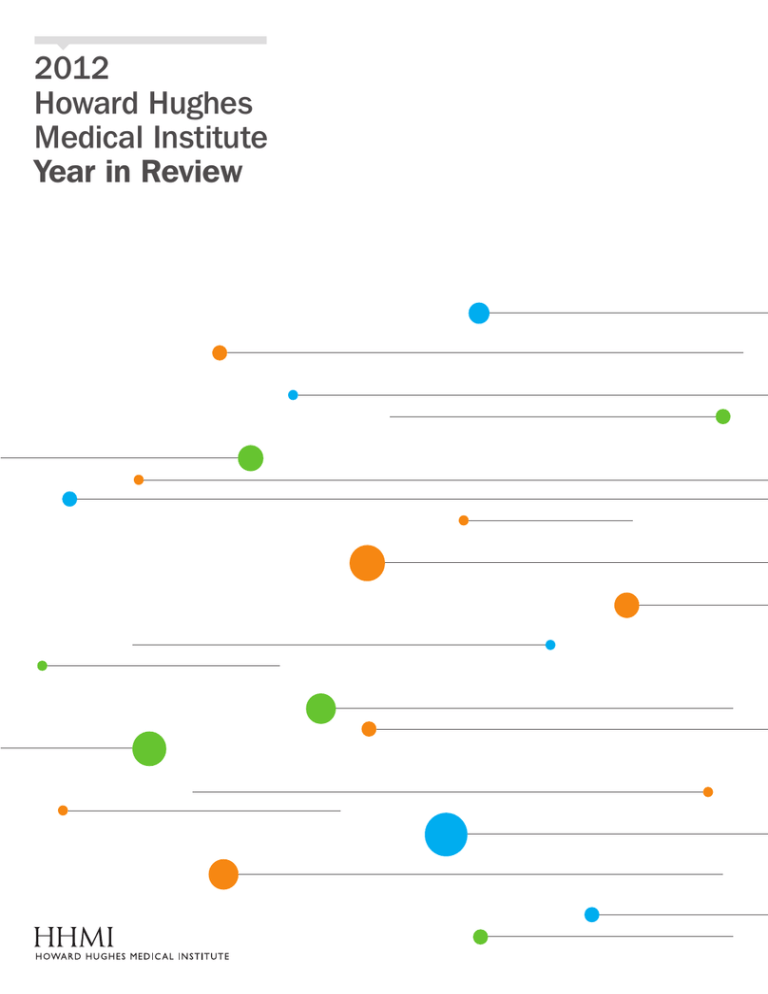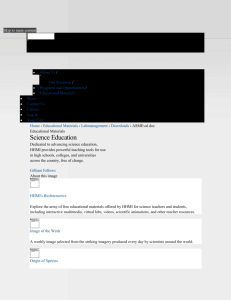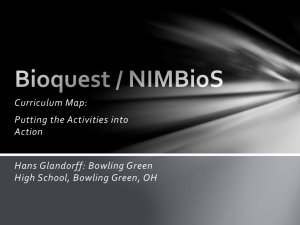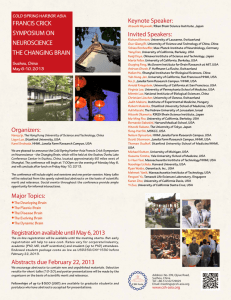2012 Year in Review | Howard Hughes Medical Institute (HHMI)
advertisement

2012 Howard Hughes Medical Institute Year in Review HHMI’s Chartered Purpose: The promotion of human knowledge within the field of basic sciences (principally the field of medical research and education) and the effective application thereof for the benefit of mankind. For the full report, please visit: hhmi.org/yir2012 From our labs HHMI scientists produce hundreds of papers every year. Read highlights from 2012, and for more information, visit hhmi.org. SEPT 2011 Horwich Honored with Lasker Prize for ProteinFolding Research HHMI investigator Arthur L. Horwich, of Yale University, and Franz-Ulrich Hartl, of the Max Planck Institute of Biochemistry, shared the 2011 Albert Lasker Basic Medical Research Award. The Lasker Awards—among the most respected science prizes in the world—recognize researchers whose insight and perseverance have led to advances that will prevent disease and prolong life. Horwich and Hartl were honored for their game-changing contributions to our understanding of how proteins fold into their functional shapes. The scientists found that proteins called chaperonins act as cage-like machines that provide a safe place for proteins to fold, away from outside interference. FREDERICK W. ALT Investigator, Boston Children’s Hospital Genetic Controller Preps Immune System for Threats Because the immune system cannot predict which invaders it will confront, it must be prepared to fend off virtually any pathogen. So immune cells reshuffle the segments of a limited number of antibody-encoding genes to manufacture billions of distinct antibodies and pathogen-recognizing receptors. Researchers discovered a genetic regulator that controls this reshuffling, an important step toward understanding how antibodies are made and how gene regulation can be coordinated across distant regions of the genome. LESLIE B. VOSSHALL Investigator, The Rockefeller University Swatting Insects’ Sense of Smell Although DEET has been used to thwart mosquitoes and other bugs for 50 years, scientists have not fully understood how it works. A new study in flies suggests that DEET confuses insects by jamming their odor receptors. Understanding how the chemical works may help researchers develop compounds that are equally effective but longerlasting or more convenient to use, which is of particular importance in parts of the world where mosquitoes and the diseases they transmit are prevalent. NOV 2011 Working Scientists Lead New Open Access Journal OCT 2011 In parallel efforts to bring compelling science stories to the classroom and beyond, HHMI’s Department of Science Education launched a short film initiative and a new production company. The short films, produced by HHMI’s Educational Resource Group, use vivid storytelling in a format suitable for the classroom. Shorts released in 2012 teach the foundational concepts of evolution and natural selection and explore Earth’s greatest mass extinction event. Tangled Bank Studios partners with filmmakers, broadcasters, and distributors around the world to create innovative programming for broadcast. Its first projects, to air on PBS networks in 2014, will feature the 3.5-billion-year history of the human body and the story of how scientists and explorers risked their lives to map the planet. An international cadre of more than 170 working scientists began reviewing and editing papers for eLife, a new open access scientific journal launched by co-funders HHMI, the Max Planck Society, and the Wellcome Trust. The eLife editorial team is composed of researchers who represent a broad range of biomedical and life science fields and share the initiative’s commitment to improve peer review and lift commercial pressures from scientific publishing. The journal began publishing its first research articles in 2012. LORA V. HOOPER Investigator, University of Texas Southwestern Medical Center ‘Demilitarized Zone’ Keeps Bacteria Where They Belong In the mammalian gut, 100 trillion bacteria help digest food and produce energy. Scientists have puzzled over how this diverse microbial community avoids triggering chronic immune reactions. According to a new study in mice, cells lining the small intestine secrete an antibacterial protein that kills any bacteria within 50 micrometers. The researchers call the resulting protective barrier the ‘demilitarized zone.’ Its loss could be involved in inflammatory bowel disease or other diseases characterized by an inflamed intestine. JOSEPH S. TAKAHASHI Investigator, University of Texas Southwestern Medical Center Structural CLOCKwork of Circadian Rhythms Every 24 hours, millions of ‘clocks’ inside our cells reset, helping tune sleep patterns, blood pressure, and metabolism. Scientists determined the three-dimensional structure of two proteins that help sync those clocks. When the proteins CLOCK and BMAL1 join inside cells, they initiate genetic events that coordinate the daily cycle. Knowing the structure of the CLOCK:BMAL1 complex will help researchers understand how mutations in the proteins cause the biological clock to go awry. Film Initiatives Bring Science to Classrooms and Homes DAVID M. KINGSLEY Investigator, Stanford University School of Medicine Record of Evolution in the Genome of a Spiny Fish Threespine sticklebacks evolved in habitats around the world from the same ocean-dwelling ancestor. Researchers sequenced the stickleback genome for the first time and found that as fish in different regions adapted to fresh water, the same genome sites changed time and again. Changes to genes and, more often, stretches of DNA that control gene activity appear to have driven sticklebacks’ adaptation to fresh-water environments. MAR 2012 Janelia Cryo-EM Facility Invites Collaboration JAN 2012 HHMI Expands Support for International Science Horwich: Brian Ach; Meteorite: HHMI; Cryo-EM Visualization: Tamir Gonen; Dixon: Paul Fetters; Science Education: Paul Fetters; Tjian: James Kegley; Illustrations: Leif Parsons In its inaugural year, the International Early Career Scientist Program awarded 28 talented young scientists $650,000 each over a period of five years to help them establish independent research programs. From 760 applicants, HHMI identified scientists who trained in the United States and have the potential to become scientific leaders in their home countries. These first HHMI International Early Career Scientists conduct research at 22 institutions in 12 countries—Argentina, Brazil, Chile, China, Hungary, India, Italy, Poland, Portugal, South Africa, South Korea, and Spain. PHILIPP J. KELLER Lab Head, Janelia Farm Research Campus Camera Captures Life Taking Shape Cell-by-Cell A new imaging technology lets users track each cell in an embryo as it forms over hours or days. The high-speed technique captures images from four different angles, compiling them to produce dramatic images of biology in action. In a single movie, comprising a million images captured over about 20 hours, viewers can see biological structures begin to emerge as a simple cluster of cells morphs into the elongated body of a fruit fly with tens of thousands of densely packed cells. A new imaging facility at the Janelia Farm Research Campus aims to attract scientists from around the world to Ashburn, VA, for groundbreaking research in structural biology and biochemistry. Dedicated to developing and optimizing cutting-edge instruments and techniques, the facility allows researchers to analyze three-dimensional structures using electron cryotomography, single particle analysis, and electron crystallography. The facility provides access to the FEI Titan Krios, one of the most complex high-resolution imaging systems in the world, which allows scientists to see the structure of biological molecules as they move within their normal environment. K. CHRISTOPHER GARCIA Investigator, Stanford University School of Medicine First Picture of a Protein Family Vital to Human Health The 20 proteins in the Wnt family are crucial to controlling how an organism develops. Interfering with these proteins has long been considered a potential way to treat cancer and other diseases. Thirty years after the first Wnt protein was discovered, scientists solved the first structure of a Wnt protein, revealing an unusual three-dimensional shape that offers clues to how the proteins function. The new structure clarifies the nature of the protein’s receptor for designers of drugs that block Wnt signaling. MAY 2012 Science Education Grants Focus Colleges on Outcomes MAY 2012 VP and Chief Scientific Officer Dixon Returns to Lab Jack E. Dixon, HHMI vice president and chief scientific officer, announced that in June 2013 he will return to his research laboratory at the University of California, San Diego. Since 2007, Dixon has maintained an active research program while directing the Institute’s flagship HHMI Investigator Program, in which leading scientists and their staff conduct research in HHMI laboratories across the United States. In this capacity, he developed new vehicles for young scientists to establish labs, including the HHMI Early Career Scientist Program, and expanded HHMI’s work into important new areas through the Hughes Collaborative Innovation Awards and the HHMI-GBMF Plant Science Investigator Program. In partnership with the University of KwaZulu-Natal in South Africa, Dixon spearheaded efforts to launch the KwaZulu-Natal Research Institute for Tuberculosis and HIV. Dixon returns to his research on protein kinases and phosphatases— biochemical “master control switches” that regulate much of the activity in living cells. HHMI investigator Erin O’Shea of Harvard University will become HHMI’s next chief scientific officer in 2013. JENNIFER A. DOUDNA Investigator, University of California, Berkeley DNA-Slicing System Borrowed from Bacteria For bacteria, snipping apart DNA at signature sequences is a defense mechanism. For scientists, the same strategy can be a powerful research tool. Scientists identified a method bacteria use to guide a DNA-cutting enzyme to specific sites in the genomes of viruses and other invaders. Taking a similar approach, they crafted a system in which an RNA guide directs DNA cleavage at a target sequence. The system may help develop biofuel-producing microbes or cell-based medical therapies. HHMI selected 47 small U.S. colleges and universities to receive grants totaling more than $50 million. The institutions will work together to create more engaging science classes, bring real-world research experiences to students, and increase the diversity of students who study science. Each four-year grant is in the range of $800,000 to $1.5 million—an amount that can have a big impact at these schools. In a change from years past, HHMI required that each application focus on a single overarching objective—rather than a checklist of required components—and include a proposal for measuring progress. TAMIR GONEN Lab Head, Janelia Farm Research Campus Kinetochore Structure Reveals How It Takes Hold To enable the inheritance of genetic information, cells copy their chromosomes before dividing. Then the pairs of identical chromosomes separate, each partner drawn toward one end of the cell by a part of the cellular skeleton known as a microtubule. To form an attachment site for the microtubule, hundreds of proteins join on the chromosome in what is known as the kinetochore complex. With the first-ever three-dimensional image of an isolated kinetochore, scientists saw how it establishes and maintains its grip. Financials From the President For scientists, confronting the unknown is a way of life. The idea of risk—that an experiment might not yield expected results or that a line of reasoning might be wrong—is not entirely negative. On the contrary, it is inherent to the process of discovery, and we often learn more from our mistakes than from anticipated results. Transformative breakthroughs often come from the boldest thinking—that which challenges conventional wisdom or dares to apply insights from one field to another. And of course, serendipity is always an exciting possibility. At the Howard Hughes Medical Institute, we embrace creative thinking and unconventional approaches because we believe that for science to achieve its full potential, there must be a certain tolerance for failure. At the Janelia Farm Research Campus and in labs around the world, our scientists frequently cross the frontiers of biomedical research because they are free to follow their instincts and ask bold questions that may take years to solve. Similarly, the Institute has refocused its science education awards on desired outcomes rather than specific tactics. Our grantees are now free to tailor education programs to the environments they know best and to try novel approaches. And, recognizing that the impact of science can be extended if it is communicated freely and articulated clearly, we are embarking on ambitious new collaborations in scientific publishing, filmmaking, and digital media. We are comfortable with uncertainty and exploring new territory but equally committed to critically evaluating our work. This ethos, coupled with patient, long-term investments in talented individuals, is the HHMI way. The Howard Hughes Medical Institute is the nation’s largest private supporter of academic biomedical research. As a medical research organization, the Institute must spend at least 3.5 percent of its endowment— HHMI’s principal source of funding—each year on direct medical research activities and related overhead, exclusive of grants and investment management expenses. At the end of HHMI’s fiscal year, on August 31, 2012, the endowment was approximately $16.1 billion. Disbursements (FY 2012) $695 M $119 M $105 M Scientific Research & Lab Construction Science Education Administration Robert Tjian, President 4000 Jones Bridge Road, Chevy Chase, Maryland 20815-6789 | www.hhmi.org



